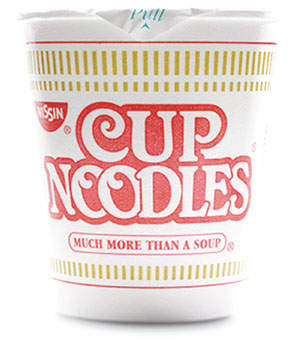Ramen Noodles are one of the Japanese pop-culture artifacts—along with anime, manga, and sushi—that international hipsterdom has chosen to embrace. In America, it is the unofficial survival ration of college students and aspiring creative types. In Silicon Valley, ramen has even worked its way into the lexicon of bootstrapping tech entrepreneurs: “Ramen profitability” is the crucial stage when a start-up earns just enough to support its founders’ modest living costs.
In Japan, ramen is the beloved staple of a country in hard times. Today’s Japan is a place of budget clothing stores, 100-yen shops, and low-malt “near beer,” whose sole attraction is that it is cheaper than the real thing. The typical Japanese salaryman gets an okozukai—the same word as a child’s allowance—doled out to him by his wife from his monthly pay packet for beer and entertainment. That allowance is lower now than at any time since the bubble economy burst more than 20 years ago, and as long as the bubble stays burst, an affordable treat like ramen is unlikely to lose its appeal.
George Solt’s The Untold History of Ramen is an attempt to show how the dish—hot broth, wheat noodles, and (usually) pork—has become part of Japan’s identity and an international success. Ramen is a steaming bowl of paradox: a Chinese import now considered quintessentially Japanese both at home and abroad, and a workingman’s comfort food that has been refined into haute cuisine among the young and hip. Ramen shops have become a signature of the Japanese urban landscape. The country has over 35,000 of them, including at least four within a five-minute walk of my suburban Tokyo apartment.
Solt makes clear that ramen owes its prominence today to Cold War politics and post-World War II American policy. Cables from April 1946, a time of near-starvation and public disorder in Japan, show General Douglas MacArthur diverting surplus American wheat to Japan to undermine “leftist elements” who were exploiting food shortages to stoke political discontent. Authorities ran campaigns to persuade people to eat wheat—traditionally only a minor part of the Japanese diet—and thank their American occupiers for it. “America is spending $250 million for your food,” ran one leaflet. “Learn to use it properly.” An effect of this campaign was the rise of the modern cult of ramen, a wheat-based dish that had entered Japan via Chinese migrants, largely in the 19th century.

The invention of instant ramen in 1958 brought the dish one step closer to world domination. (Japan now consumes 45 servings of instant noodles per person per year. By 2005, instant noodles sales hit $6 billion annually.) In the early 1970s, Nissin Foods launched Cup Noodle, the form of ramen best recognized outside Japan. The Styrofoam-packaged product, exported to Europe and America (where it is known as Cup Noodles), pared down the equipment needed to enjoy ramen to just a plastic fork. Back home, Cup Noodle became famous as a food consumed in harsh conditions and natural disasters.
In the 1980s bubble economy, ramen was caught up in the “gourmet boom”—an explosion of conspicuous consumption in which food became, in Solt’s phrase, “a form of entertainment with fetishistic undertones.” Ramen guidebooks proliferated, chefs became celebrities, and obsessive fans took to driving hundreds of miles to line up for hours outside the most famous shops. At one point, Solt compares ramen to pizza, which is somewhat apt. Both fit somewhere between fast food and a formal meal—hearty, filling, warming—and both have an outsize cultural significance. But even in a place like New York, the American love affair with pizza seems a little shallow next to Japan’s infatuation with ramen. Yokohama even has a theme park-like ramen museum that draws over a million visitors a year.
Merely to say that ramen is “popular” hardly describes how tightly the Japanese have woven ramen noodles into the fabric of their food culture—and few things have more totemic significance in Japanese culture than food. Television sometimes seems to consist entirely of people eating, with close-up shots of the moment’s reflection before the obligatory “Oishii!” (“Tasty!”) Many Japanese will express pride in the country’s food (although they often temper that pride with an odd expectation that non-Japanese people will be unable to stomach the most characteristic Japanese dishes, such as raw fish and fermented soybeans). The devotion to culinary detail can be almost ritualistic. Coffee shop “masters” can take 15 minutes to prepare a simple—yet faultless—cup of coffee, and more than once when I’ve ordered a whisky on the rocks, the bartender has asked not only what whisky but also what consistency of ice I prefer.
And yet ramen shops can be almost scruffy—formal and ritual-bound by American standards, perhaps, but gritty and down-to-Earth compared to higher- class Japanese restaurants that serve sushi, tempura, or wagyu beef. The ramen-shop patron, typically a young man, buys his ramen ticket from a machine and takes his place at the counter to slurp his noodles alone, usually in just a few minutes.
With increasing numbers of young people stuck in temporary jobs with poor benefits, ramen’s associations with the optimistic, look-ahead years of the postwar economic boom surely add to its flavor. A recent Cup Noodle advertising campaign shows a team of hungry young job-seekers struggling through a polar bear-infested wilderness, and presumably sustained by instant ramen. The ad is captioned Employment Ice Age: Since 1993.
But the taste of an economy on the rise—with all the associations, both politically and culinary, that Solt memorably condenses here—is what the Japanese ramen fans really crave. Perhaps the current government’s policies will succeed in stimulating the Japanese economy, and the days of gold-leaf sake will return. In the meantime, Japan’s second generation in the wintry job lines can at least console itself with some of the most delicious hard-luck comfort food in the world.
This post originally appeared in the May/June 2014 issue ofPacific Standardas “The Ramen Index.” For more, subscribe to our print magazine.




